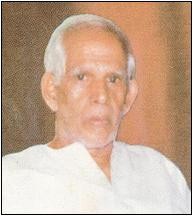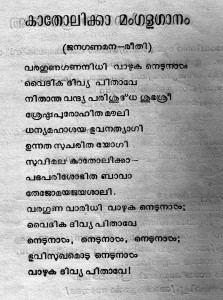The Rebirth of the Golden Days by Dr. Meledath Kurian Thomas
വരഗുണ വാരിധി വാഴുക നെടുനാൾ വൈദിക ദിവ്യ പിതാവേ….
നിതാന്ത വന്ദ്യ പരിശുദ്ധ ശുഭശ്രീ ശ്രേഷ്ഠ പുരോഹിത മൌലി
ധന്ന്യ മഹാശയ ഭുവനത്യാഗി ഉന്നത സുപരിത യോഗീ..
സുവിമല കാതോലിക്കാ പദ പരിശോഭിത ബാവാ…
തെജോ മയജയ ശാലീ ….
വരഗുണ വാരിധി വാഴുക നെടുനാൾ വൈദിക ദിവ്യ പിതാവേ….
നെടുനാൾ നെടുനാൾ നെടുനാൾ ഭുവിസുഖമോടു നെടുനാൾ
വാഴുക ദിവ്യ പിതാവേ…..
Dr. Meledath Kurian Thomas
United Arab Emirates: Malankara Orthodox Syrian Church is going to witness an historic event, the resurrection of the Catholicate Anthem of the Malankara Orthodox Syrian Church which was abandoned for about quarter a century. On 14 September 2015, AD 52 ANTHEM, a team of 14 youngsters from the UAE, will re-launch the Catholicate Anthem which begins as ‘Vara Guna Gana’ in connection with the anniversary of the establishment of the Catholicate in India.
The Catholicate anthem has an interesting story. From 1925 onwards it was a custom to chant a Catholica Mangala Ganam, a sort of poetic citation, during the receptions and public meetings attended by the Catholicos of the East. But it was not with any uniformed format. Mostly, it was just a poetic composition by some local hands in any one of the Syriac or Malayalam tunes. Such compositions never survived beyond one or two functions.
In 1951, C. P. Chandy, later honoured as Sabha Kavi – the poet of the Church – wrote a Catholica Mangalapatra Ganam by the inspiration and assistance of Rev. Pathamuttom M. C. Kuriakose Remban. It was in the tune of the Syriac liturgical chant “Thurod Sinai” with seven stanzas beginning with “Catholica, Simhasana Vedi…“. It was first used in a great Catholicate public meeting held at Kottayam on 31 Kanni, 1951.
In 1952 Rev. Pathamuttom M. C. Kuriakose Remban published this Catholica Mangalapatra Ganam in his book titled ‘Prasanga Yoga Mitram’. The uprising of the ‘Catholicate Sprit’ in 1950’s among the Malankara Nazranis along with this book popularised this composition and it was used universally in honour of the Catholicate.
Even though this composition was not in a format of an anthem, its popular tune and inspiration of its content made it so accepted that even the common people memorised it. Beyond the description of the greatness of the Catholicate in India, it also carried the personal description of the then Catholicos H. H. Baselios Geevarghese II, like his deep sound, physical characters and pastoral nature. Without considering the logic, it was used as the Catholicate Anthem, even after his demise in 1965 for further a decade.
In October 1975, H. H. Baselios Marthoma Mathews I was enthroned as the Catholicos of the East. He instructed Sabha Kavi Shri. C. P. Chandy, with whom the former composed almost all of the liturgical texts in Malayalam, to write a brief but powerful Catholicate Anthem. In 1976, C. P. Chandy created the beautiful composition of “Vara Guna Gana” in the tune of India’s National Anthem. It was published in the official hand book for the Catholicate Day celebrations, which falls on the 36th day of the Great Lent annually, starting 1977. Its punch, because of the simplicity of its tune with the spirit of patriotism, made it a household fame within no time. It became a custom to chant this Catholicate Anthem whenever the Catholicate flag was hoisted and at the conclusion of public meetings attended by the Catholicos of East.
“Vara Guna Gana” was chanted for more than a decade. The ‘Prevention of Insults to National Honour Act’, an Act of the Indian Parliament which prohibits desecration of or insult to the country’s national symbols, including the National Flag, The Constitution, and the National Anthem. On this context, the Holy Episcopal Synod of Malankara Orthodox Syrian Church was forced to think about an alternative. Instead of considering any modifications over the so popular “Vara Guna Gana” to overcome the legal barrier, the Church adopted “Marthoma Simhasanathil…” composed by Shri. Abraham Padinjarathalakkel in 1987 as the “Catholica Mangala Ganam”, initially written as an OVBS song. It became official since 1989.
Even though “Marthoma Simhasanathil…” is a beautiful poem composed elegantly, it had a lot of hindrances that never made it popular. Apart from its long duration, it is not at all composite to suits the standards of any anthem that raises the pride of the Catholicate. Marthoma Simhasanathil… can be well chanted only by a well trained choir. The chanting of Catholicate Anthem has now become namesake as it is cut short at times and use of varied melodies by different choirs.
Team “AD 52 Anthem” have re-composed the legendary “Vara Guna Gana…” in a new style by retaining its old charm and vigour beyond all legal barriers. The team AD 52 ANTHEM under the leadership of Sam Thomas, a musician who hails from Delhi with a team of 8 Singers will re-launch “Vara Guna Gana…” on 14 September 2015. I am sure this new creation from these fervent youngsters will reach out to ignite the “Spirit of Catholicate” in the Malankara. Let it will bring back the golden days when “Vara Guna Gana…” was chanted at every occasion. This initiative is a tribute to H. H. Catholicos Baselios Marthoma Mathews I, the great and Sabha Kavi C. P. Chandy of blessed memory.
Response from a Reader
A part of the article titled ‘Resurrection of the Catholicate Anthem “Vara Guna Gana” – Reprise’ by Dr. Meledath Kurian Thomas published in ‘Malankara Orthodox TV reads as follows.
Quote-
In October 1975, H. H. Baselios Marthoma Mathews I was enthroned as the Catholicos of the East. He instructed Sabha Kavi Shri. C. P. Chandy, with whom the former composed almost all of the liturgical texts in Malayalam, to write a brief but powerful Catholicate Anthem. In 1976, C. P. Chandy created the beautiful composition of “Vara Guna Gana” in the tune of India’s National Anthem.
-Unquote
The response of Mammen M. Oommen to my article, Resurrection of the Catholicate Anthem – “Vara Guna Gana” – Reprise, worth an explanation. There is no factual error in my said article. But I do agree that it lack some information which I never knew.
Regarding the role of Baselius Marthoma Mathews I in the birth of “Vara Guna Gana” as the Catholicate anthem, I stated in my article as … In October 1975, H. H. Baselios Marthoma Mathews I was enthroned as the Catholicos of the East. He instructed Sabha Kavi Shri. C. P. Chandy, with whom the former composed almost all of the liturgical texts in Malayalam, to write a brief but powerful Catholicate Anthem. I never claimed that Holy Father had any creative contribution in its creation as in the case of 1951 Catholica Mangalaganam composed by Sabha Kavi C. P. Chandy. There was a creative contribution of Fr. M. C. Kuriakose Remban in 1951 Catholica Mangalaganam as I mentioned. Hence, an earlier date of composition of “Vara Guna Gana” made no factual error in my article.
It is a fact that Holy Father instructed C. P. Chandy in 1976 to write a powerful Catholicate anthem. Perhaps the later draw Holy Father’s attention to his earlier composition, as you said, “Vara Guna Gana” instead of writing a fresh one. Probably realizing the strength of it, Baselios Marthoma Mathews I accepted it as the Catholicate anthem without any change.
The point is, until 1976, “Vara Guna Gana” was just a song among many composed by C. P. Chandy. Perhaps it was never used again until 1976 after the Pathanamthitta Conference of 1965 you mentioned. “Vara Guna Gana” becomes the Catholicate anthem only in 1977 after the initiative taken by Holy Father. Without his initiative, it would never be the Catholicate anthem. Even if it was written in 1965, the real birth of the Catholicate Anthem took place only in 1976. This itinerary justifies my argument.
I omitted one piece of information in my above stated article. In fact, Sabha Kavi C. P. Chandy wrote a Catholica Mangalaganam for H. H. Baselius Augen I too. But it was seldom used and never accepted officially. It was in the tune Eanono Nuhro. I remember only a few lines of it. They are … Karthavin thiru avatharatal, punyam petta palstheenil, palavattom nivasippan bhagyam, kittiya vandhya mahacharya… That too was with such personal descriptions. The strength of “Vara Guna Gana” lies in its non-personal nature. Acceptance of such a universal anthem instead of a personal Mangalaganam shows the vision of Baselios Marthoma Mathews I, the great.
Even though there are no factual errors in my article, thanks to Mammen M. Ommen since his response provides an opportunity to make it clearer.
Dr. Meledath Kurian Thomas





